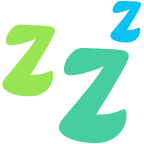Sleep Disorder Terminology
Respiratory Event Types and Scoring Criteria:
Obstructive apnea: Cessation of airflow (≥90% decrease in apnea sensor excursions compared to baseline), lasting at least 10 seconds, with 90% of event duration meeting the amplitude criteria. Obstructive apneas are associated with continued or increased effort throughout the entire period of absent airflow
Central apnea: Cessation of airflow (≥90% decrease in apnea sensor excursions compared to baseline), with 90% of event duration meeting the amplitude criteria. Central apneas are associated with absence of inspiratory effort throughout the entire period of absent airflow
Mixed apnea Cessation of airflow (≥90% decrease in apnea sensor excursions compared to baseline), with 90% of event duration meeting the amplitude criteria. Mixed apneas are associated with absence of inspiratory effort at the start of the event, followed by return of inspiratory effort during the second portion of the event
Hypopnea: A reduction in airflow (≥30% reduction in nasal pressure signal from baseline), lasting at least 10 seconds, with 90% of event duration meeting the amplitude criteria. Hypopneas are associated with an oxygen desaturation of at least 3% or an EEG arousal
RERA: Respiratory Effort Related Arousal – a sequence of breaths ≥10 seconds, with increasing respiratory effort or flattening of the nasal pressure signal leading to an EEG arousal during sleep (scored when criteria for hypopnoea is not met)
Periodic Limb Movement (PLM) of sleep: Movements of the limbs occurring with a specific frequency, duration, and amplitude.
Level 2 Sleep Study
Device Used: Nox A1
Signals Recorded: EEG, EOG, ECG, EMG, Thoracic & Abdominal Effort (RIP), Position, Audio (Snoring), Pulse Rate & Waveform, Nasal pressure, calRIP Flow, Ambient Light, Oxygen Saturation (+/- additional signals)
Index as an indication of severity
AHI - Apnoea Hypopnoea Index:
Normal: < 5/hr
Mild OSA: AHI 5 ≤ 15/hr
Moderate OSA: AHI 15 ≤ 30/hr
Severe OSA: AHI > 30 events/hr
Terminology Commonly Used in Sleep Test Reports
REM sleep: Rapid Eye Movement
NREM sleep: Non-Rapid Eye Movement (Stage 1, 2 and 3)
REM latency: time it takes from sleep-onset to the first period of REM sleep
Sleep latency: how long it takes for a patient to get to sleep. From time of lights off to the start of the first epoch of any stage of sleep
WASO: Wake After Sleep Onset. Any time spent awake after sleep onset
Arousal: abrupt shift of EEG frequency during a minimum of 10 sec of sleep prior for >3 seconds
Arousal Index: indicates frequency of all types of arousals per hour of total sleep time
AHI: Apnea Hypopnea Index - indicates frequency of obstructive events (#apneas
+ #hypopneas) per hour of total sleep time (TST)
RDI: Respiratory Disturbance Index – indicates frequency of respiratory events (#RERA + #apneas + #hypopneas) per hour of total sleep time (TST)
ODI: Oxygen Desaturation Index - indicates frequency of a blood's oxygen desaturation drop of ≥3% or more from baseline per hour of total sleep time (TST)
Sleep Efficiency (%): Total Sleep Time / Total Recording Time (“lights on” to “lights off”) x 100
Nadir Oxygen Desaturation - From the ASA guidelines it states:
- severe oxygen desaturation has been classified as an oxygen saturation <85% for more than 2% of the total PSG sleep time
- minimal or no desaturation has been classified as no PSG sleep saturation less than 90%
- oxygen saturation of <85% for more than 50% of sleep time (breathing air) has been suggested as another threshold value defining severe sleep-related hypoventilation
Please Note: These figures are just a guideline as there is no standardised index:
97%> Normal
<90% Mild
<85% Moderate
<80% Severe
Treatment Devices Abbreviations
CPAP: Continuous Positive Airway Pressure – a fixed pressure is delivered to the patient
APAP: Automatic Positive Airway Pressure - automatically adjusts to the patient’s pressure requirements
BiPAP or VPAP: Bi-level or Variable pressure device that provides two levels of pressure. Inspiratory Positive Airway Pressure (IPAP) and a lower Expiratory Positive Airway Pressure (EPAP) for easier exhalation
Screening Tests
ESS: Epworth Sleepiness Scale –a short questionnaire that determines the likeliness of the patient to fall asleep in certain situations. The total score is out of 24, a score above 10 indicates an above average sleepiness









